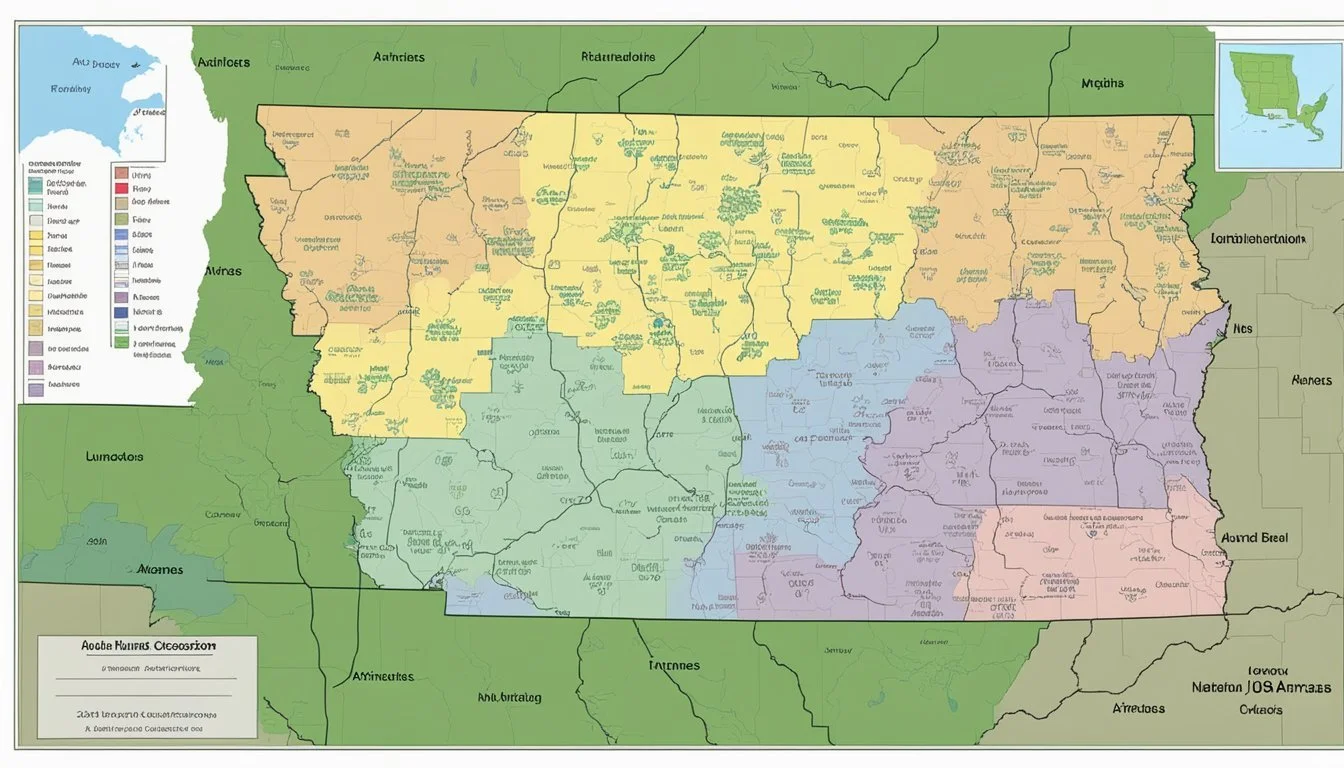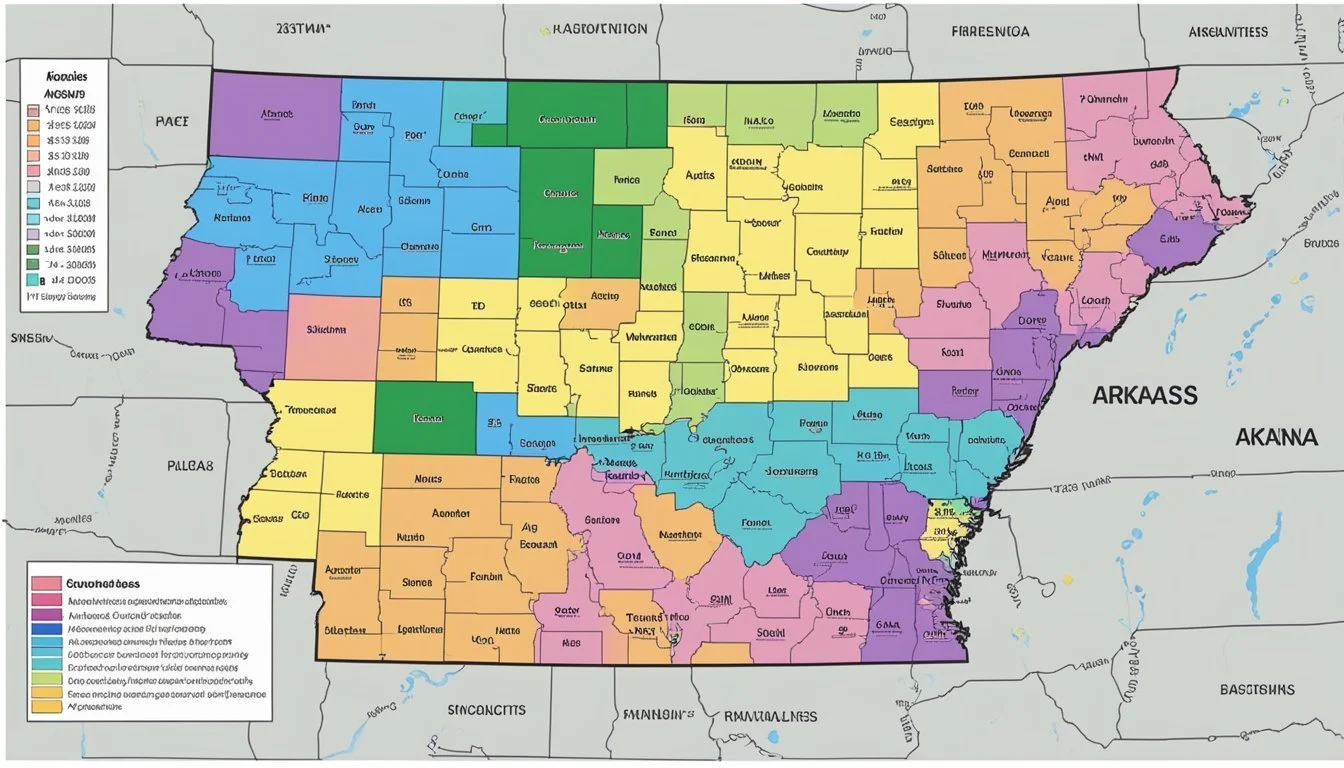USDA Hardiness Zones in Arkansas
A Guide to Successful Gardening
Understanding the USDA Plant Hardiness Zone Map is crucial for gardeners and growers in Arkansas as it guides them through selecting the most appropriate perennial plants for their gardens and farms. Released by the United States Department of Agriculture, the Plant Hardiness Zone Map identifies distinct zones across the country by the average annual extreme minimum winter temperature. This system, marked in 10-degree Fahrenheit zones and 5-degree Fahrenheit half zones, is an essential tool in assessing which plant species can endure the local climate and has been updated to reflect climate trends and geographic data meticulously.
Arkansas, with its diverse topography and varying climates, spans multiple hardiness zones. The zones range from cooler temperatures in the northern parts of the state to warmer regions in the south. The state's gardeners rely on the updated hardiness zone information for an informed approach to planting and cultivating a successful garden. The recent map adjustments take into account the subtle yet significant climate changes over the years, ensuring that the growers in Arkansas have the most current data to base their planting decisions on.
For those who reside in the state of Arkansas and engage in horticulture or agriculture, constant consultation of the USDA Hardiness Zone Map is a best practice. This map is the gardeners' cornerstone in understanding the relationship between climate and plant survival, helping them to plan landscapes that are both beautiful and resilient. Whether new to gardening or possessing a green thumb, utilizing this resource can make a significant impact on the success of plant growth and sustainability in Arkansas's varied environments.
Understanding USDA Plant Hardiness Zones
The USDA Plant Hardiness Zones are essential for gardeners and growers to determine the suitability of perennial plants for their locales. They are based on regions defined by average annual extreme minimum winter temperatures.
Definition of Hardiness Zone
A Hardness Zone is a geographically defined area indicated by the USDA Plant Hardiness Zone Map where a specific category of plant life is capable of growing, as defined by climatic conditions, particularly the minimum temperatures. The map divides North America into 13 primary zones, each of which represents a 10-degree Fahrenheit span of average annual extreme minimum temperatures.
Purpose and Importance for Gardeners
Hardiness zones guide gardeners and growers in making informed decisions about which plants can thrive in their region. Understanding one's local hardiness zone helps in selecting plants that are most likely to survive the winter. The zones reflect local climates and provide a framework for predicting plant survival and growth. For example, a gardener living in an Arkansas hardiness zone will select plants rated for that zone to ensure they can withstand the typical winter temperatures experienced in that area.
Arkansas's Climate and Hardiness Zones
Arkansas's varied climate is divided into specific USDA Hardiness Zones. These zones help gardeners understand what plants can thrive in their region based on temperature extremes.
Overview of Arkansas's Climate
Arkansas experiences a humid subtropical climate, typified by hot summers and mild to cool winters. Temperature fluctuations largely dictate the USDA Hardiness Zones within the state, which range from 6a to 8a.
Geographic Variation and Elevation Influences
The state's region and topography create distinct climate variations. For example, the Ozark Mountains have cooler temperatures and a different hardiness zone than the lower Mississippi Delta region.
Microclimates Within Arkansas
Localized microclimates can cause deviations from broader zoning. Factors like urban heat or small valleys can influence temperature, leading to variations not always captured by wider weather stations data.
Navigating the USDA Plant Hardiness Zone Map
The USDA Plant Hardiness Zone Map is an essential tool for gardeners and agriculturists in Arkansas, providing valuable information on which plants are best suited for cultivation in specific locations. By using the map's search functionality and understanding the detailed zonal divisions, individuals can make informed decisions for successful gardening.
Using the USDA Plant Hardiness Zone Map
Arkansas gardeners can access the USDA Plant Hardiness Zone Map by entering a specific zip code into the search box provided. This action reveals the plant hardiness zone relevant to that region. The tool is user-friendly and is designed to guide users in selecting plants that will likely thrive in their particular climate zone. The map is a result of extensive climatic analysis, implying that the data is not only current but also extremely credible.
Understanding Half Zones and Transition Areas
In addition to the main zones, the Plant Hardiness Zone Map delineates half zones, denoted by 'a' and 'b', representing 5-degree F temperature differences within a main zone. For example, zone 6a and 6b may experience slightly different climatic conditions, affecting plant survival and growth. Transition areas between zones are especially crucial for gardeners looking to push the boundaries of plant hardiness. These zones inform gardeners of the risk a plant may have in terms of survival, allowing them to carefully consider their planting strategy.
Plant Selection for Arkansas Gardeners
When selecting plants for gardens in Arkansas, understanding your specific USDA Hardiness Zone is crucial for a thriving landscape. The right plants will not only grow, but flourish for years to come.
Choosing the Right Plants for Your Zone
Arkansas' diverse climate maps from zones 6a through 7b, indicating a wide range of minimum temperatures from -10°F to 10°F which gardeners must consider. It's imperative to choose plants that are suited to these temperatures to ensure plant survival and health. A visit to the USDA Plant Hardiness Zone Map provides an accurate starting point for gardeners to identify their specific zone. Here is a quick reference for plant selection based on hardiness zones in Arkansas:
Zone 6a (-10°F to -5°F): Hardy deciduous trees and shrubs
Zone 6b (-5°F to 0°F): Resilient flowering perennials
Zone 7a (0°F to 5°F): Broadleaf evergreens and tougher perennials
Zone 7b (5°F to 10°F): A variety of fruit trees and ornamental plants
By aligning plant selections with these zones, Arkansas gardeners can create a vibrant garden more likely to withstand the local winter climate.
Considerations for Perennial Plants
Selecting perennial plants for the Arkansas climate requires attention to not only their cold hardiness but also their ability to handle the heat and humidity of the region's summers. Perennials that thrive across Arkansas must be able to adapt to these conditions. For example, daylilies, coneflowers, and hostas are known for their resilience and ability to return each year with minimal care. Using local resources, such as the guide provided by Plantmaps for Arkansas Interactive USDA Plant Hardiness Zone Map, can aid gardeners in making informed choices for their perennial gardens.
It's not just about survival; choosing the right perennials will bring color and life to gardens year after year. Gardeners should look for those that not only match their hardiness zone but also complement the garden's design in terms of color, texture, and bloom time.
Hardiness Zones and Seasonal Gardening
Understanding USDA Hardiness Zones is vital for successful seasonal gardening in Arkansas, where zone variations influence planting schedules and crop selections. This section discusses preparations for winter and strategies for gardening through spring and fall.
Preparation for Winter
As winter approaches, Arkansas gardeners should assess their garden's specific hardiness zone to determine the right time to prepare for cold temperatures. In Arkansas, zones typically range from 6a to 8a, making it pivotal to know one's exact location on the map to anticipate the first frosts. Preparing involves selecting cold-tolerant plants and mulching to provide a protective layer that insulates the soil and roots against snow and freezing conditions. It is also the time to prune any sensitive branches to prevent snow damage and ensure robust growth in the spring.
Gardening Through the Spring and Fall
Spring and fall are critical times for gardening in Arkansas's varied hardiness zones. During these seasons, one can cultivate a wide array of both annuals and perennials, taking advantage of the mild temperatures and reduced pest pressure. In the spring, gardeners should start by enriching the soil, taking care to mix in compost before planting to promote healthy growth. Popular choices like alyssum (aly) and calendula (cale) fare well during these seasons and can add vibrant color to any Arkansas garden. As fall approaches, gardeners are advised to plant cool-season crops and to seize the opportunity for late-season growth before the first frost arrives, ensuring a bountiful harvest.
The Impact of Climate Change on Hardiness Zones
Climate change is redefining the geographical boundaries of USDA Hardiness Zones in Arkansas. As temperatures inch upward, zone classifications adjust to reflect these changes.
Observing Trends and Updates
National and regional analyses show that Arkansas's Hardiness Zones are affected by a warming climate. Recent updates have illustrated a northward shift in zones, signifying a rise in minimum temperatures. Gathered data highlights the specific alterations in temperature trends and its implications on growing degree days. This shift aligns with national observations, where interior states show a half-zone migration northward. These insights are crucial for agricultural planning and understanding the long-term effects of climate change on local ecosystems.
Adapting Gardening Practices to Shifting Zones
Gardeners and farmers across Arkansas are adapting their practices due to changes in hardiness zone classifications. They are adjusting their plant selections and planting schedules to ensure that their practices align with the updated temperature benchmarks. As they witness their traditional Hardiness Zones update to reflect warmer climates, it becomes essential to adopt new strategies for plant care and crop rotation to maintain successful horticulture and agriculture within the state.
Additional Resources for Arkansas Growers
Arkansas growers have a variety of resources at their disposal to optimize their gardening and agricultural efforts. Key to success is understanding the specific USDA Plant Hardiness Zone of your location and utilizing educational materials and community support tailored to these zones.
Local Gardening Organizations and Communities
Arkansas offers a wealth of local gardening organizations that support growers in understanding the nuances of their specific zone, whether that's zone 1's frigid temperatures or zone 13's warmth. These groups often provide forums for discussing best practices for tree care and overall plant survival, given Arkansas' range of hardiness zones.
Arkansas Federation of Garden Clubs: Connects gardening enthusiasts for knowledge sharing.
County Extension Services: Offers localized advice for growers in different zones.
Educational Material and Support
The survival of plants in Arkansas hinges on an understanding of the extreme minimum temperatures associated with each zone. Educational materials, largely based on research from Oregon State University, help clarify how light and temperature affect plant hardiness.
USDA Plant Hardiness Zone Map: Essential for identifying suitable plants for each location.
University of Arkansas Cooperative Extension: Provides resources and workshops for growers.
Growers in Arkansas are encouraged to leverage these educational resources to increase the chances of successful cultivation in their unique zone. Each entity, from Oregon State University to local clubs, plays a crucial role in supporting the horticultural community. Careful attention to the hardiness zones, which span from the cold of zone 1 to the tropical warmth of zone 13, typically found in Puerto Rico, ensures the robust growth and survival of plants across the United States.
Frequently Asked Questions
The USDA Plant Hardiness Zone Map provides vital information for gardeners in Arkansas to determine the best plants for their area and the optimal time to plant them. This section covers common inquiries about the zones specific to the state.
Which plants are best suited for growth in Zone 8a in Arkansas?
In Arkansas's Zone 8a, gardeners can successfully grow a variety of perennial plants such as coneflowers, crepe myrtle, and Japanese maples, which are all well-adapted to this zone's temperature range.
How can I find the USDA Hardiness Zone for my specific zip code in Arkansas?
Gardeners can locate their specific USDA Hardiness Zone by visiting a hardiness zone map and entering their zip code, which provides a precise zone designation for their area.
What are the recommended planting zones for various parts of Arkansas?
Arkansas encompasses USDA Hardiness Zones ranging from 6a to 8a, with the southeastern region typically being warmer, hence classified in Zone 8a, and the northwestern region classified downwards through Zone 6a.
How do the USDA Hardiness Zones vary across Arkansas?
Across Arkansas, USDA Hardiness Zones vary significantly, with lower zones generally found in the northwestern highlands and higher zones in the southeastern lowlands, reflecting the state's diverse topography and climate.
What is the gardening zone designation for Little Rock, Arkansas?
Little Rock, Arkansas, is located within USDA Hardiness Zone 7b, meaning it experiences average extreme minimum temperatures of 5 to 10 degrees Fahrenheit.
In what hardiness zone would I be gardening if I live in Northwest Arkansas?
If one lives in Northwest Arkansas, they would be gardening in USDA Hardiness Zone 6b, which has an average extreme annual low of -5 to 0 degrees Fahrenheit.






